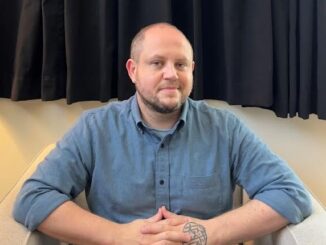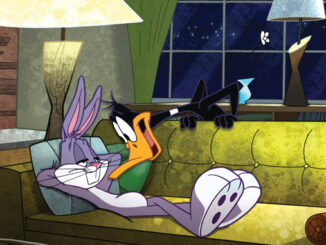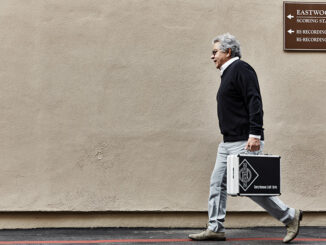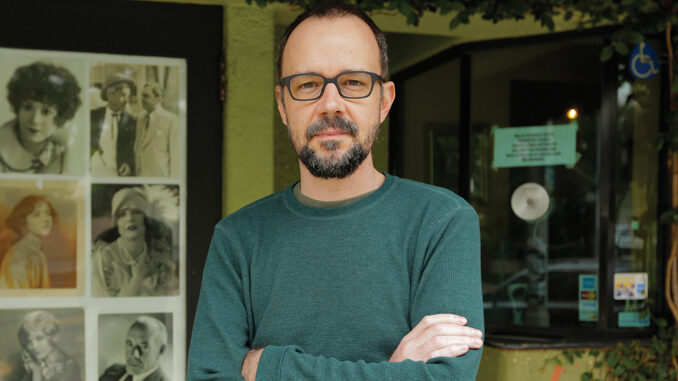
by Rob Feld
Darrin Navarro came to editing via a familiar path: An interest in movies led him to film classes at Los Angeles City College. Within a week or two of seeing what could be done by manipulating the choice of moving images, he knew this was the job for him. A professor got him an internship filing trims with Roger Corman’s New Horizon company, which led Navarro to kick around the low-budget exploitation world for a while, picking up gigs as he could.
The first job that made him feel like a real assistant editor, though, was a position on Sam Raimi’s Darkman (1990) for nine months. “It was a great way to get some chops, make a lot of mistakes and not suffer greatly for it,” Navarro remembers. It was a step up for him and, shortly thereafter, he was able to join the Editors Guild.
Navarro stayed an assistant for 14 years, doing a number of films at Paramount and developing a strong relationship with post-production executive Paul Haggar. Three of these films were William (Billy) Friedkin’s and edited by Augie Hess. When Friedkin was preparing to direct Bug (2006) — based on Tracy Letts’ play of the same name — and Hess was occupied by another project, Navarro got the call. He had edited one indie film by this point, but his collected experience seemed to be enough when Friedkin asked if he was ready to take on Bug.

Courtesy of Liddell Entertainment
The resulting collaboration led to a follow-up on Killer Joe, set for release July 27 through LD Entertainment. Another dark tale laden with danger, violence and atmosphere, and also based on a Letts play, the film concerns a Texas family in a trailer home and the man they hire to kill an ex-wife/mother.
“For me, Bug and Killer Joe back-to-back was a perfect marriage of director and material,” Navarro tells CineMontage in an exclusive interview. “Letts and Friedkin finding each other was one of the best things to happen to movies in a long time — a match made in heaven.”
CineMontage: Killer Joe spends a great deal of time in a claustrophobic trailer home and relies a great deal on Tracy Letts’ wonderful language. How did you and William Friedkin talk about the challenges this posed?
Darrin Navarro: Billy doesn’t make a movie until he has seen it in his head. In that sense, there wasn’t a whole lot to discuss about overcoming the challenge of a confined space because he had worked that out with Tracy in the writing and location choice. Billy has a specific purpose for every shot he makes. Ideally, he will shoot one take. He can easily be talked into a second take, but not so easily into a third.
CM: What is Friedkin’s working relationship with Letts like?
DN: Billy regards Tracy as one of the great writers of our time and is loath to change any of his words. Outside of the actors having the freedom to perform the scene as they need — and they are generally very respectful as well — Tracy has a stylized way of writing that is very much his own, but is probably more in keeping with theatrical than movie dialogue. The meter and picturesque quality of his words are very important to what happens.
In Killer Joe, the idea was to make something that would hit the ground running from the first scene.
CM: How did that respect for Letts’ dialogue affect the way you cut the film?
DN: It’s a challenge to really ratchet up the pace of the movie in post- production and not start taking out words. We were able to apply a kind of pacing and jump-cutting — particularly in the early parts of the movie — that allowed us to keep all of the words, but almost layer them on top of each other. We compressed the space of the interior of the trailer by not letting the characters walk across space unless they were actually delivering lines at the same time.
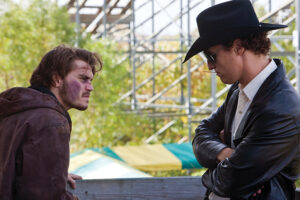
One of the things that you’ll see, especially in that opening scene, is that they aren’t jump cuts from within the same shot. It’s a normal cutting pattern, but we compress time so that characters will take a step out of one shot and, on the incoming cut, will arrive at their destination, which might be 20 feet away. What that did was allow us to keep all the words and to give a kind of bantery pace to the scene, which was not necessarily there in the performance. It became rapid- fire dialogue. It also subtly sends to the audience the message of the compressed space, and that all these characters are right on top of each other.
Particularly when the end scene comes, you want to feel like there’s no escape and that it’s an uncomfortable situation — not only because of what’s happening, but because of the close quarters holding all of these antagonistic relationships. It really has more to do with how you manage pacing in a situation where the words are golden. Only with great trepidation would you take words out.
CM: You seem pleased that Friedkin gives you so few takes to work with. Does he do a great deal of rehearsing to achieve this?
DN: He has a remarkable sense for casting and for counter-intuitive casting. After that, he gets his actors into the space, rehearses with them a bit in the morning and then lets them go. Camera operators and everybody else on set are told that actors are free to do whatever they have to do. Billy winds up creating an intensely real environment in which lives are being lived in front of the lens. That gives me an embarrassment of riches. When I saw the dailies on Bug, I knew I would have to be the worst editor in the world to mess them up because every take was on fire. One of the great perks of working with a guy who’s been making movies for 50 years is that I don’t have to try and save the movie. It’s a nice position to be in.
CM: Is Friedkin so precise in what he wants that the footage forces the cuts? Does he give you any runoff or do you have some leeway?
DN: His shots tend to be very purposeful but, at the same time, he does want his performances to be real, so he will let the actors play out a significant portion of the scene. Admittedly, it’s a slightly different setting than your average film because Bug and Killer Joe are theatrically based, so scenes tend to be much longer than they would in another film. So, when I say he lets it run for a significant portion of the scene, we could be talking about two or three pages. But for me, based on what the actors are doing and the camera, I just know this shot is for this. He makes it so that a take’s purpose is very evident.
“Friedkin really shoots the movie knowing first what is in his head.”
CM: Does he storyboard?
DN: He does not storyboard as a rule, and I’ve actually heard him advocate against it. With Billy, you never see the same camera setup twice; you’re always looking at any actor or corner of that space in a different way than you did previously. In Bug, the lighting changed. It started out as more realistic and kind of red, but as things start to get weird, the movie becomes more yellow and the angles start to get disorienting. Of course by the end — when the tinfoil is up everywhere and hung with bug killers — the entire movie is blue and the pacing changes; we’re jump- cutting much more heavily at the end. If you missed the middle of the movie, you wouldn’t necessarily know you were in the same place from beginning to end.
In Killer Joe, Billy does the same thing, only to a lesser extreme. The physical space itself is not redecorated, but you cannot find the same setup twice anywhere in the film, so it feels more like a movie than a play; it’s cinematic because the camera is constantly repositioning the audience and how they relate to the trailer.
CM: Your other main director collaboration has been with Azazel Jacobs on Momma’s Man [2008] and Terri [2011]. Can you contrast your working relationships there?
DN: Friedkin really shoots the movie knowing first what it is in his head, whereas Aza is restlessly experimental in the editing room. I will think that we have re-imagined a scene in as many ways as possible when Aza will say, “What if…” I’ll tell him it won’t work because of something fundamental, a rule you don’t break. But he introduced me to a phrase I’ve started to use: “Pretend for a minute that doesn’t matter.” It almost always produces something amazing. He’ll push us to make another six versions of the scene I thought was doomed — and make something that no one would have thought was possible. He really is tireless about that.

CM: How else is Jacobs’ directorial style different?
DN: Aza also knows how a shot can take on power the longer you look at it. If you stare at an object or word for 40 seconds, you realize at the end you don’t recognize it. He understands that if you frame a shot correctly, stage it and direct your actor correctly, a shot can accumulate power over a period of time, so he’s not afraid of a long take. I will often tell directors when I start working with them, “I don’t see my role as making cuts in your film. My role is to figure out ways to avoid making cuts in your film.” It should take a real good reason to stop an actor when he’s on, or cut a shot that’s working.
CM: You’ve worked predominantly in film, but you have spent time in TV. What are the differences for you?
DN: Dramatic television, by and large, is plot-driven and fueled by dialogue. In general, I find that what movement, action and aesthetic there is in the photography is there to keep it interesting — but it isn’t what the show is about.
A movie is much more like a symphony. You have long stretches at a certain tempo, and when that tempo changes there is a huge shift in what the audience is experiencing. You can have whole passages in a film in which very little is said, but it’s communicating volumes to the audience. Terri was about people who are not particularly verbose, who get through life communicating with expressions and their bodies. Where a lot of the joy in editing comes from for me is using an actor’s face and body — and the revelation of space that the actor occupies — as a way of getting across the emotions and ideas of the film.
In television, you very rarely have the opportunity to use those elements to that degree. Both are perfectly valid ways of making motion pictures, however, and they each have their distinct appeals.
CM: Can you cite any influences that have highlighted many of these points for you?
DN: I am a voracious movie watcher. I make it a point to see all kinds of films from different eras, from all different parts of the world. I’m constantly looking for precedents, in a way looking for permission in the works of as many different filmmakers as I can find to see how film language functions. If you grew up with movies and television, you intuitively know the basics of Howard Hawks’ invisible style of shooting and editing, in which everything is based on the line and close-ups, and medium and wide shots have these understood purposes and meanings. But there are whole other ways in which the camera, light, shadow, color and tempo can have an effect. Most of what I try to bring to the movies on which I work are things I’ve found and enjoyed in other movies.
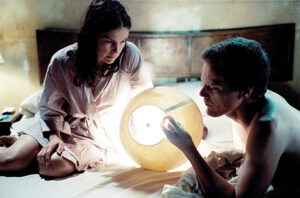
CM: Can you give me an example?
DN: Michael Haneke’s Caché [2005], which I saw at the time we were working on Bug. It was one of the scariest things I had ever seen. I was working with Friedkin, who had previously made one of the scariest things I had ever seen [The Exorcist, 1973]. I had never seen a Haneke film before that; I have since become a bit of a devotee. I told Billy he must see the film, that it was like Bergman and Hitchcock but it would freak him out. He saw it and raved about it.
A week later, he brought in a DVD of Haneke’s Funny Games [1997], which Tracy Letts had given to him. We became this Michael Haneke fan club. We were already underway with Bug, but I know there were times when we were working on some of the scenes — particularly when Agnes and Peter are getting to know each other — and the audience just doesn’t know which way it was going to go. We were at liberty to just watch actors Michael Shannon and Ashley Judd react to one another for long periods of time, and we didn’t feel we needed to rush it.
CM: What was the effect that Caché had on the film?
DN: If you’ve got an actor who’s really on the mark — and of course Haneke’s actors are always on the mark — the more time you take watching them figure out their situation and what the other person’s motivations are, the longer you have to consider the worst possible outcome to a situation, and it becomes almost unbearable. Which is why Haneke’s films are so much more frightening than a horror movie in which the worst possible thing happens on a regular basis.
To me, real horror is anticipating it, and you’re not so much worried about the person it is going to happen to. You almost become more worried about the person who’s going to do it because they have usually gone through some journey where they were living this normal, respectable life but circumstances have turned them into the kind of person who can do something horrible. You experience that transformation in real time and it’s horrifying.
Would Bug have been different had we not seen Caché? I don’t know. But I know we talked about it a lot and felt it was giving us permission told do certain kinds of things with the
pacing of that film.



